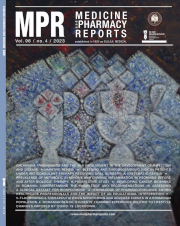Two case reports of mesenteric and retroperitoneal actinomycosis and a narrative review of the relevant literature
DOI:
https://doi.org/10.15386/mpr-2073Keywords:
actinomyces, actinomycosis, retroperitoneal, mesenteric, abdominal, mesocolic massAbstract
Introduction. Actinomycosis is an uncommon subacute or chronic suppurative bacterial granulomatous infectious disease with clinical heterogeneity. The majority of actinomycosis cases were of extra-abdominal origin, with oro-cervico-facial cases representing 55%, abdominopelvic representing 20%, and thoracic representing 15% of total reports. Currently, abdominal actinomycosis incidence is approximately 1 case per 119,000 people, being found three times more frequently among males. We report two rare clinical presentations of abdominal actinomycosis affecting the mesentery and the retroperitoneum, respectively.
Case Report 1. A 58-year-old Caucasian male presented to our clinic with abdominal pain in the right upper quadrant. Pre-operative evaluation, although inconclusive, showed a mesocolic mass infiltrating the right and transverse colon. The patient underwent exploratory laparotomy. After partial resection of the mass, the histopathology report demonstrated mesenteric actinomycosis.
Case Report 2. A 40-year-old Caucasian male presented to our clinic complaining about a mucopurulent material from an orifice at the right inguinal region. After appropriate work-up, a large abdominopelvic, stellate mass (75 x 22.8 mm) in the retroperitoneum was revealed. Surgery along with the appropriate antibiotics was used to treat the patient.
Conclusion. Preoperative suspicion and diagnosis of actinomycosis are very challenging, with a high rate of misdiagnosis often resulting in delayed treatment. Our case reports highlight that abdominal actinomycosis should always be part of differential diagnosis, especially when there is involvement of multiple organs. The gold standard treatment of actinomycosis is surgical excision with prolonged antibiotic treatment.
Downloads
Published
How to Cite
Issue
Section
License
The authors are required to transfer the copyright of the published paper to the journal. This is done by agreeing to sign the Copyright Assignment Form. Whenever the case, authors are also required to send permissions to reproduce material (such as illustrations) from the copyright holder.

The papers published in the journal are licensed under a Creative Commons Attribution-NonCommercial-NoDerivatives 4.0 International License.

